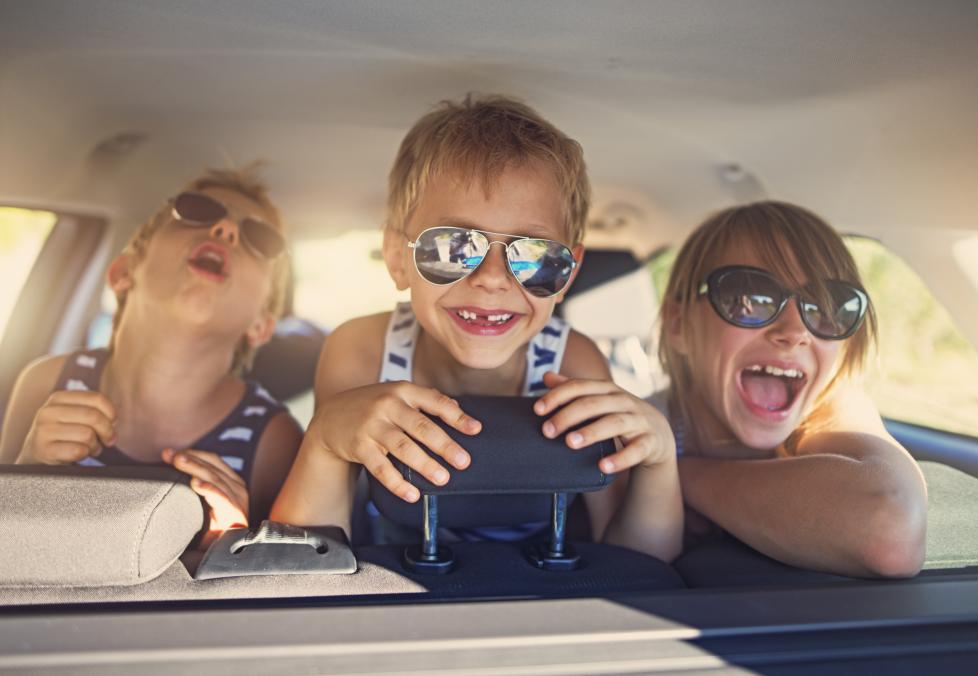
Book an eye exam, take advantage of our popular two-pair offers, restock your contact lenses — or all three!
Everything you need to know to take care of your eyes — for life.
Sunglasses are just as important as sunscreen. Here’s what parents need to know to protect kids’ eyes today, tomorrow, and beyond.

Enjoying the outdoors is not only great for your kid’s health and fitness, but it can also sharpen their vision.
A recent study at Queensland University of Technology in Australia found that playing in the sunshine can prevent myopia (nearsightedness) in kids—and slow its progression as kids grow up.
But without the right protection, sunlight can also cause some serious eye problems. “We wouldn’t let the kids play outside without slathering them with sunscreen,” says David A. Damari, O.D., president of the Association of Schools and Colleges of Optometry. “But kids’ eyes need protection, too, just like their skin does.”
That’s because the cornea of a young child—the clear protective outer covering of the eye—is thinner and more vulnerable than it will be at any time of life.
Eye exams are an essential part of your health care routine. Book an appointment with your America’s Best optometrist today! Click here to find a time that fits your schedule.
The harmful UVA and UVB rays that we guard our kids’ skin against can also do some damage to their eyes.
“A day at the park can mean a lot of UV exposure,” Dr. Damari explains. “And the more kids’ eyes are exposed, the earlier in life they’ll get cataracts—a clouding of the lens inside the eye and behind the iris. That’s usually a condition of older people.”
Researchers at the University of Alicante in Spain found that UV rays can cause complications in the retina and cornea. Each hour spent in the sun without proper protection, scientists say, increases the chance of developing changes in the lens by 4%.
And kids don’t have to wait decades for an eye problem to appear. Overexposure to the sun can also cause photokeratitis, or a sunburn of the eye, which can even result in temporary blindness.
Or, says Dr. Damari, “Ultraviolet exposure over a significant amount of time could also cause your child to develop a pterygium. That’s when a skin structure starts to develop on the side of the eye and grows over the cornea. And once kids start down that path, they’re likely to have fairly routine eye problems from then on.”
If you notice your kids have bloodshot or swollen eyes, or that they’re hypersensitive to light, their eyes might have been overexposed to the sun’s harsh UVA and UVB rays.
Luckily, there’s a simple solution: sunglasses. Here are some tips for choosing the best protective (and stylish!) shades for your child.

Book an eye exam, take advantage of our popular two-pair offers, restock your contact lenses — or all three!
UV protection. Ideally, find sunglasses that boast 100% UVA and UVB protection (the tag will say UV400), but at a minimum aim for 98 to 99%. Make sure your kids wear them whenever they’re outside—even on cloudy days.
Comfortable fit. Make sure the sunglasses fit snugly, stay secure, and don’t pinch little noses or ears. For babies and toddlers, sunglass straps can help keep the shades in place. Consider wraparound glasses for the most complete coverage from sun protection.
Fun frames. Pick a pair of sunglasses your child will want to wear. “Let them try the glasses on and pick out the ones they like,” says Dr. Damari. “When they’ve had some buy-in, they’re more likely to wear the sunglasses.”
Indestructability. Dr. Damari suggests looking for lenses made of polycarbonate or other impact-resistant materials. Rubber frames are a solid choice for comfort and long wear, while spring hinges can help ensure the frames stay in put—despite constant tugging.
If your child wears prescription eyeglasses, you might be imagining looming battles where you're nagging your child to pack his sunglasses in his backpack and he's responding with a quick, Yeah, whatever!
But there's a better option: Transitions lenses. These are the prescription lenses that automatically adjust to the surrounding light. No matter what shade they turn, they block 100% of UV rays—plus they're impact-resistant and cut glare.
That means you and your child can spend your mornings looking for lost library books and missing sneakers—and not worry about shielding his eyes from the sun. Win-win!